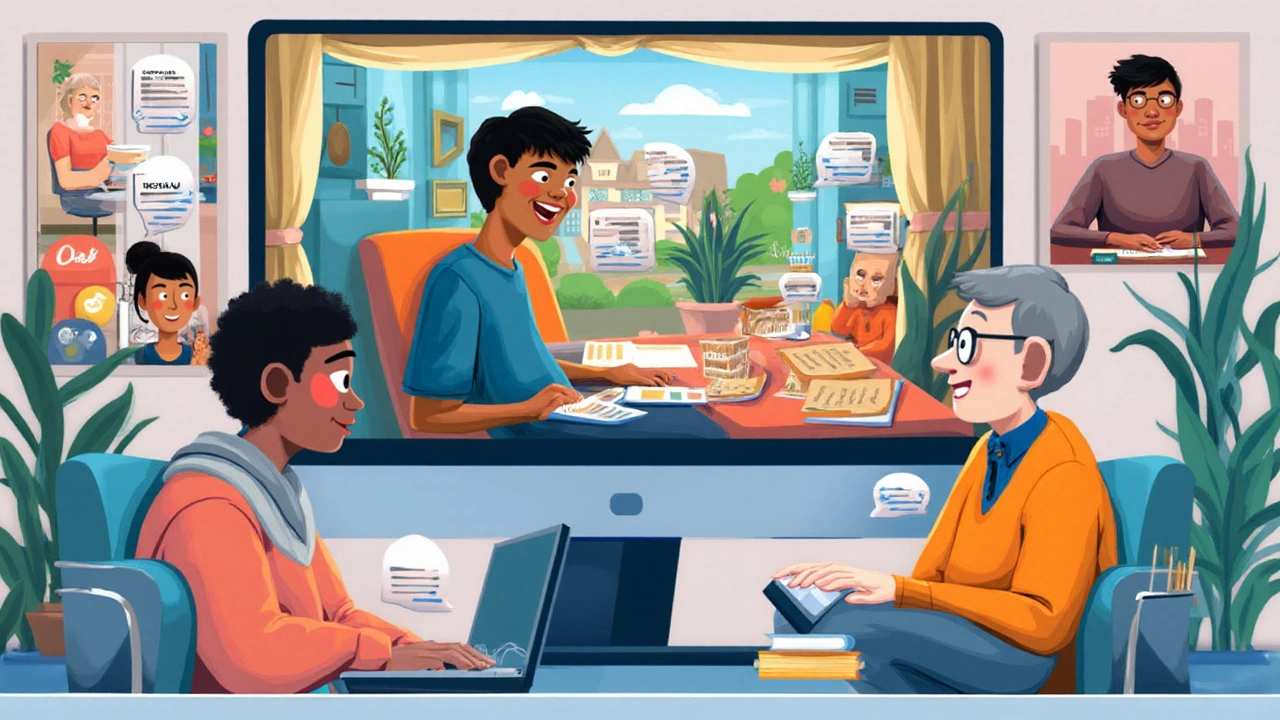9 out of 10 college students have tried at least one online class. That’s how quickly distance learning has become normal – but what does it actually mean? The term gets thrown around, but if you picture lonely Zoom calls or endless assignments on your laptop, you’re only seeing part of the picture. There’s a whole world behind those screens, with its own rules, surprises, and a few landmines you’ll want to avoid. Let’s pull back the curtain on what distance learning implies, who it helps, and what you absolutely need to know to make it work for you—or your family.
The Real Definition and Scope of Distance Learning
Start with the basics: distance learning isn’t just about working from home in your pajamas. Technically, it’s any type of education where teachers and learners are separated by time, place, or both, and technology bridges the gap. This can mean live lessons where everyone logs on at the same time (synchronous), or on-demand courses you chip away at whenever you want (asynchronous). There’s school, college, job training, language classes, and even professional certifications—all redesigned to work away from physical classrooms.
Most people instantly think of computers or tablets, but distance learning used to happen through mailed paper lessons or radio broadcasts. In 2025, though, we’re talking mostly about video calls, interactive modules, online quizzes, forums, mobile apps, and even VR classrooms. Some schools use a hybrid approach, mixing digital with face-to-face, but every version demands a different set of skills from what we learned in ‘old-school’ classrooms.
Just how big is this? According to UNESCO, more than 1.5 billion students globally experienced remote learning during the 2020 pandemic. In the UK, Open University—a pioneer here—has been running huge remote programs for nearly 50 years, proving that this isn’t a passing trend. And since major companies now accept (or even prefer) online degrees in fields like IT and business, distance learning is firmly part of mainstream education, not just a backup plan.
It’s important to draw a line between distance learning and terms like ‘e-learning’ or ‘online learning.’ E-learning is narrower—just the digital tools. Distance learning covers everything: the tools, the method, and the community built around it. The same course could ‘happen’ in real time with group chat and instant feedback, or play out over weeks with no set schedule. What ties them together is the separation: you don’t sit in a sweaty classroom, but you still reach your goals from wherever you are.
The variety is huge. You’ve got traditional colleges reworking their modules, tiny expert-led workshops, free MOOCs (massive open online courses) like Coursera or edX, and whole virtual schools for kids. Some programs even throw in live peer-to-peer coaching or career advice calls. If you grew up dodging blackboards, it’s kind of mind-blowing how far ‘school’ has come.
The Pros and Cons: Beyond the Obvious
Let’s sort the hype from reality. Distance learning is amazing for a lot of people—but it can also pile on new kinds of stress. The biggest perk for most? Flexibility. You can study at home, a café, or while traveling. Busy parents, full-time workers, or people with health issues can pace themselves without the pressure to show up in a specific place. If you’re easily bored by one-size-fits-all lessons, distance learning lets you move faster or slower as you like.
It also opens the doors to more people. No matter where you live—city, small town, overseas—you can access world-class teachers or programs, ditching the need to relocate or commute. That’s huge, especially for students in rural or remote regions. Stats back this up: The National Center for Education Statistics found a 186% increase in American K-12 students enrolled in online schools from 2019 to 2024.
There’s cost savings, too. Without commuting, moving, or hefty campus fees, distance programs tend to be budget-friendly. Some universities even report up to a 40% drop in total student expenses. Add in free learning resources, open-source textbooks, or virtual libraries, and the costs only shrink further.
But it’s not all smooth sailing. Dropping out is shockingly common. A 2023 study by The Open University showed a 30% higher dropout rate for distance learners compared with campus students. Why? A mix of self-discipline struggles, social isolation, and tech headaches. It’s harder to ask questions on the spot, easy to fall behind, and not everyone enjoys staring at screens all day.
Social interaction takes a hit, too. If you crave in-person friendships or the buzz of group debate, virtual classes can feel empty. Building connections online takes way more effort. Sometimes you miss non-verbal cues or get stuck waiting hours for replies.
And while distance learning is more accessible for many, it isn’t for everyone. Students with unreliable internet, outdated computers, or challenging home environments can struggle. There’s a real risk of widening the digital divide—unless schools, governments, or charities step in with better tech support. That makes planning ahead crucial if you’re thinking of making the switch.

Skills You’ll Need (That Nobody Teaches in School)
What makes someone great at distance learning? Spoiler: It’s not genius IQ or lightning-fast typing. It’s all about personal skills you usually don’t learn in a traditional school setting. Distance learning takes self-motivation, focus, digital know-how, and strong communication online—skills you never knew you needed until grades are on the line.
You’re your own boss now. With flexible schedules and no one watching over your shoulder, you need to manage your own time and stay organized. That starts with making a study plan—set a routine, put up sticky notes, or use a simple calendar app. Some students swear by the Pomodoro Technique: work for 25 minutes, take a five-minute break. You’ll be shocked at how much you can do with short sprints instead of marathon study binges.
Digital skills are non-negotiable. You’ll be logging onto platforms like Moodle, Blackboard, or Google Classroom—sometimes three or four different apps a day. If tech isn’t your strong suit, give yourself a crash course before classes begin. Practice uploading files, joining video calls, and searching for troubleshooting guides online. Many schools offer virtual walk-throughs or how-to videos for new joiners, so ask for them early.
Communication gets turned upside down. You can’t just wave your hand for help—instead, you have to craft clear emails, post on forums, or book teacher office hours. Quick tip: If you’re stuck, don’t wait hours to speak up. The squeaky wheel really does get the grease online, and polite persistence beats silence every time.
Don’t ignore your mental health, either. Set up a real workspace—even if it’s a corner of your bedroom—and put your phone away when class starts. Use blue-light filters at night. Try online study groups for accountability. One UK survey in late 2024 found that distance learners with weekly video check-ins are twice as likely to finish assignments on time. A little human connection still makes all the difference.
Smart Hacks, Tools, and Stats for Better Distance Learning
Want to go beyond just surviving—actually thrive in this virtual setup? Here are some practical tips, tools, and facts to make life easier. First, sort out your tech. A stable connection and noise-canceling headphones aren’t luxuries, they’re basics now. Check your computer’s up to date, and keep a phone charger nearby (you’ll need it by midday, promise). If your WiFi’s dodgy, consider WiFi extenders or use wired ethernet when you can.
Second: structure your learning. Use cloud-based tools like Google Drive or Notion to organize notes and deadlines. Try habit trackers or productivity apps—Forest, Todoist, and Notion are big favorites among students. Take advantage of built-in ‘do not disturb’ modes when you need to zone in.
Don’t get lost in the online crowd. Introduce yourself in forums, join (or start) virtual study groups, and keep your camera on during live classes if you can—teachers are 60% more likely to remember students who participate visually, according to a University of Edinburgh 2023 study.
Finally, ask for support. Every good distance learning platform has help desks or live chat support. If you’re struggling, reach out to student services or check if there are peer mentors. Sometimes even a five-minute call can stop small problems from snowballing.
| Fact | Source/Year |
|---|---|
| 90% of higher ed students have enrolled in at least one online course | QS Top Universities, 2025 |
| Distance learners save up to 40% in total educational costs | Open University UK, 2024 |
| Students with weekly video check-ins complete 2x more assignments on time | University of Leeds, 2024 |
| Distance learning dropout rates are 30% higher than in-person | The Open University, 2023 |
| K-12 online school enrolment grew by 186% from 2019 to 2024 | NCES, 2024 |
If you’re starting your distance learning journey, you’re not alone—even if it sometimes feels that way. People of all ages are adapting, struggling, and absolutely smashing it every day. With the right tools, some fresh routines, and a dash of patience, you really can make distance learning not just doable, but surprisingly rewarding. It’s never been about just passing exams—it’s about building tomorrow’s smarts, one login at a time.


Write a comment